In today’s digital landscape, our laptops are vital companions in navigating our daily routines. Yet, when faced with a non-charging Macbook, productivity can grind to a halt.
By becoming adept at diagnosing and resolving these issues, we not only empower ourselves but also streamline our workflow.
In this guide, we’ll delve into common reasons behind a Macbook not charging, from malfunctioning cables and obstructed ports to battery troubles and SMC-related glitches.
Let’s dive into the symptoms of each problem, arming you with the insight needed to pinpoint the source when your Macbook goes on strike against charging.
Identifying Macbook Charging Issues
Identifying Macbook Charging Cable Issues
Charging cable issues are a common cause of Macbooks not charging.
If your Macbook isn’t charging, the first step is to check if the cable is damaged or not.
Look out for any breaks, tears, or external damages on the cable. If you notice any deformities, the cable could be the reason why your Macbook isn’t charging.
You can also try using a different charger for your Macbook and see if it’s able to charge your computer. If it does, it means your charger was faulty.
Dirty or Blocked Charging Port
A dirty or blocked charging port is another possible reason why your Macbook isn’t charging. Debris, dust, and lint can accumulate inside the charging port over time and block the charger from making good contact.
- Check your port for any blockages and clean it carefully.
- Use a clean, dry, and lint-free cloth or a can of compressed air to gently clean the port. Once it’s clean, try charging it again.
Possible Battery Issues
Battery issues can also cause charging problems. If your battery is faulty or if it has expired its lifecycle, your Macbook might not charge.
Check if the battery status icon displays “Service Battery” or “Replace Now”. This typically indicates that your battery might be defective and needs replacement.
System Management Controller (SMC) Related Issues
The System Management Controller (SMC) in your Macbook is responsible for many low-level functions, including battery management.
Sometimes, SMC issues can result in charging problems. If your Macbook isn’t charging and you’ve ruled out the charger and battery as the problem, resetting the SMC could solve the issue.
- To do this, shut down your Macbook, then press and hold the power button for 10 seconds.
- Release the button, wait a few seconds, then press the power button to turn the Macbook on.
Related: Troubleshooting AirPods Not Charging in Case
Software Related Issues
Sometimes, software issues can interfere with the Macbook’s ability to charge. If you haven’t updated your MacBook’s software in a while, it could lead to charging issues.
Ensure you update your software regularly and keep your Macbook running on the latest macOS version.
If the issue persists, booting your system in safe mode can help identify if a run-away process is causing a power issue.
Hardware Related Issues
Occasionally, hardware issues such as a faulty logic board, a malfunctioning USB-C port, or a bad power adapter can cause your Macbook not to charge.
In such cases, you may need professional help to diagnose and fix the issue. If your Macbook is under warranty, consider taking it to the Apple Store or an authorized repair center to identify and address any hardware-related charging issues.

Related: MacBook Pro Not Charging Issue: Causes and Solutions
Resolving Hardware-Related Charging Issues
Identifying the Problem of Macbook Not Charging
One of the first things to do is to identify the problem. Make sure the MacBook isn’t charging by checking the battery icon in the Menu Bar.
No battery symbol or a symbol with an “X” denotes a hardware charging problem.
Inspecting the Charging Cable
Physical damages may cause the inability of the MacBook to charge. Check for bent prongs or frayed wiring. If there are signs of physical damage, replace your charger.
Examining the MacBook’s Charging Port
The MacBook’s charging port can accumulate dust and dirt over time which may eventually affect charging.
A blocked charging port will prevent the charger from fully connecting to the device. Use a wooden or plastic toothpick to remove debris, carefully avoiding the use of metal to prevent short circuits.
Be gentle and careful not to damage the connectors within the port.
Related: How To Force Shut Down MacBook
Testing with a Different Charger or Outlet
Sometimes, the charger may not be the issue. Trying a different charger can help identify if the problem lies with the charger or the MacBook.
Also, testing with different electrical outlets can rule out the possibility of a faulty outlet.
Checking for Physical Damage on the MacBook
Physical damage may also affect the MacBook’s charging capabilities. Look for visible signs of damage like dents or cracks on the MacBook, specifically near the charging port area.
If there’s no visible external damage, internal parts like the logic board or battery may be faulty and may require professional attention.
Using System Information Tools
If these steps don’t resolve the issue, check System Information Tools to verify the battery condition.
- Click on the Apple menu > About This Mac > System Report > Power.
- The “condition” field should show “normal”.
- If it shows “replace soon”, “replace now”, or “service battery”, contact Apple Support.
Resetting the System Management Controller (SMC)
If your MacBook appears to run normally except that it won’t charge, you may need to reset your System Management Controller (SMC).
SMC controls various low-level functions on your MacBook including charging and battery management. The steps to reset SMC vary by model, so refer to official Apple guides to reset it properly.
Remember, if the issue persists, immediate professional help from Apple technicians is recommended to prevent further damage and cost associated with a faulty charging system.

Resolving Software-Related Charging Issues
Understanding The Role of The System Management Controller
The System Management Controller (SMC) plays a critical role in managing several hardware components of your MacBook, including power-related functions. It controls the charging of your MacBook’s battery, amongst other things, and an issue with the SMC might be the cause of your MacBook not charging.
Resetting The SMC
Resetting the SMC can remedy issues related to battery and power. Here’s how you do it:
- Shut down your MacBook.
- Press and hold the power button for 10 seconds, then release it.
- Wait a few seconds, then press the power button again to turn on your MacBook.
For MacBooks with a T2 Security Chip (released in 2018 or later), follow these steps:
- Shut down your MacBook.
- Press and hold the right Shift key, the left Option key, and the left Control key for 7 seconds.
- Keep these keys held down and then press and hold the power button as well.
- Hold all keys and the power button for 10 seconds.
- Release all keys, wait a few seconds, then press the power button again to turn on your MacBook.
Checking For Software Updates
Apple often releases software updates that can resolve a number of issues, including charging problems. To ensure that your MacBook’s software is up to date, follow these steps:
- Click on the Apple icon in the top-left corner of the screen.
- Select “System Preferences” from the drop-down menu.
- Click on “Software Update”.
- If updates are available, click “Update Now”. If prompted, you may need to click “Agree” to accept the software license agreement.
Remember, before updating your software, always back up your data to prevent any potential loss.
Identifying Software-Related Charging Issues
If the above steps don’t solve your charging issues, try identifying any recently installed software or applications that may be causing the problem.
- Start your MacBook in safe mode by pressing and holding the Shift key as you start up your MacBook.
- While in safe mode, check to see if your MacBook charges. If it does, a recent software or application may be causing the problem.
- Restart your MacBook normally to exit safe mode. Uninstall any software or applications you suspect may be causing the problem.
If these steps do not solve the charging issues, it might be a hardware-related problem, and contacting Apple Support would be recommended.
Conclusion
Whether it’s knowing how to clean a dirty port, check for charging cable damage, test with a different charger or outlet, or address physical damages on the Macbook itself, resolving hardware-related charging issues become less of a challenge.
Similarly, understanding the role of the System Management Controller (SMC) in charging, learning how to reset it, and keeping an eye out for software updates that could rectify charging problems guides us in solving software-related challenges.

J.S. is the owner, content creator, and editor at Upgrades-and-Options.com. I’ve worked in the IT and Computer Support field for over 20 years. The server hardware in my computer labs has mostly been IBM, but I’ve supported Dell, HP, and various other hardware. In addition, as part of my lab administrator responsibilities, I’ve learned, supported, and repaired/upgraded network hardware such as Cisco routers and switches. READ FULL BIO >>
- How to Replace Your Laptop Battery: A Step-by-Step Guide
- Shut Down a Lenovo Laptop: Quick and Easy
- Why Is My Computer So Slow? Ways to Fix It Now!
- Connecting Your AirPods to Your Windows Laptop
- How to Easily Update Realtek 802.11 N WLAN Adapter Drivers for Seamless Connectivity
- How to Troubleshoot a Black Screen on Lenovo Legion 5 15ACH6H
- Lenovo Laptop Freezing – How To Fix
- SSD Not Showing Up In Bios Or Windows | Easy Fix


